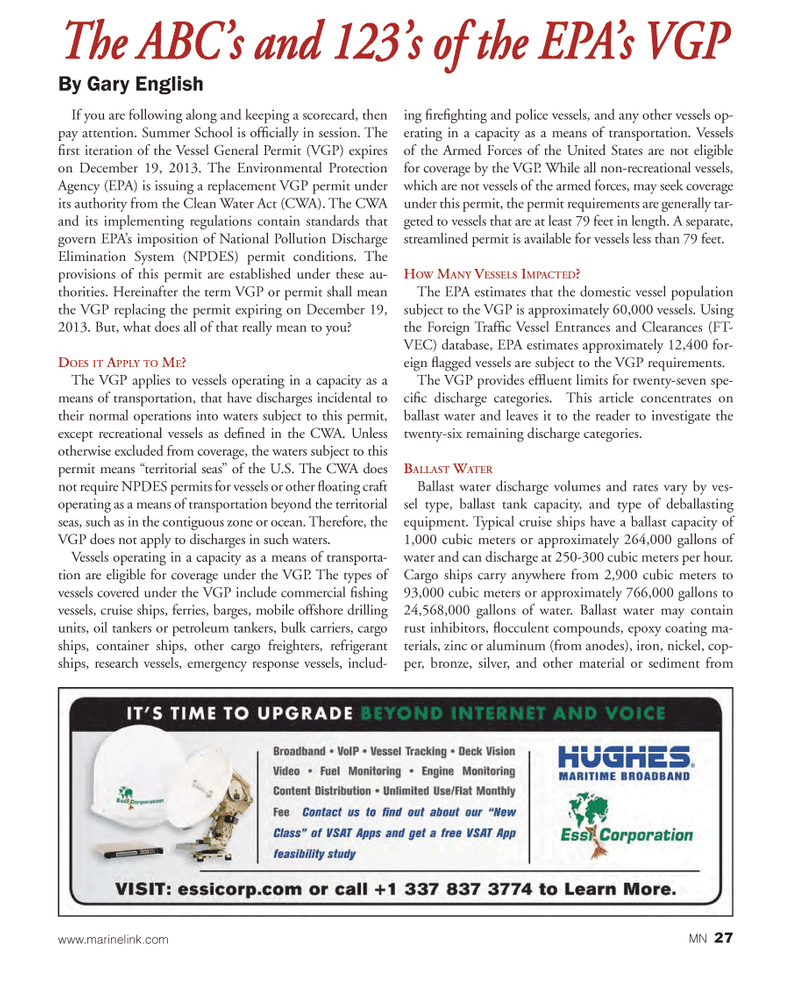
Page 27: of Marine News Magazine (July 2013)
Propulsion Technology
Read this page in Pdf, Flash or Html5 edition of July 2013 Marine News Magazine
If you are following along and keeping a scorecard, then pay attention. Summer School is of? cially in session. The ? rst iteration of the Vessel General Permit (VGP) expires on December 19, 2013. The Environmental Protection Agency (EPA) is issuing a replacement VGP permit under its authority from the Clean Water Act (CWA). The CWA and its implementing regulations contain standards that govern EPAs imposition of National Pollution Discharge Elimination System (NPDES) permit conditions. The provisions of this permit are established under these au- thorities. Hereinafter the term VGP or permit shall mean the VGP replacing the permit expiring on December 19, 2013. But, what does all of that really mean to you? DOES IT APPLY TO ME? The VGP applies to vessels operating in a capacity as a means of transportation, that have discharges incidental to their normal operations into waters subject to this permit, except recreational vessels as de? ned in the CWA. Unless otherwise excluded from coverage, the waters subject to this permit means territorial seas? of the U.S. The CWA does not require NPDES permits for vessels or other ? oating craft operating as a means of transportation beyond the territorial seas, such as in the contiguous zone or ocean. Therefore, the VGP does not apply to discharges in such waters. Vessels operating in a capacity as a means of transporta- tion are eligible for coverage under the VGP. The types of vessels covered under the VGP include commercial ? shing vessels, cruise ships, ferries, barges, mobile offshore drilling units, oil tankers or petroleum tankers, bulk carriers, cargo ships, container ships, other cargo freighters, refrigerant ships, research vessels, emergency response vessels, includ- ing ? re? ghting and police vessels, and any other vessels op- erating in a capacity as a means of transportation. Vessels of the Armed Forces of the United States are not eligible for coverage by the VGP. While all non-recreational vessels, which are not vessels of the armed forces, may seek coverage under this permit, the permit requirements are generally tar- geted to vessels that are at least 79 feet in length. A separate, streamlined permit is available for vessels less than 79 feet. HOW MANY VESSELS IMPACTED ?The EPA estimates that the domestic vessel population subject to the VGP is approximately 60,000 vessels. Using the Foreign Traf? c Vessel Entrances and Clearances (FT- VEC) database, EPA estimates approximately 12,400 for- eign ? agged vessels are subject to the VGP requirements. The VGP provides ef? uent limits for twenty-seven spe- ci? c discharge categories. This article concentrates on ballast water and leaves it to the reader to investigate the twenty-six remaining discharge categories. BALLAST WATER Ballast water discharge volumes and rates vary by ves- sel type, ballast tank capacity, and type of deballasting equipment. Typical cruise ships have a ballast capacity of 1,000 cubic meters or approximately 264,000 gallons of water and can discharge at 250-300 cubic meters per hour. Cargo ships carry anywhere from 2,900 cubic meters to 93,000 cubic meters or approximately 766,000 gallons to 24,568,000 gallons of water. Ballast water may contain rust inhibitors, ? occulent compounds, epoxy coating ma- terials, zinc or aluminum (from anodes), iron, nickel, cop- per, bronze, silver, and other material or sediment from The ABCs and 123s of the EPAs VGP By Gary English www.marinelink.com MN 27MN July2013 Layout 18-31.indd 276/27/2013 1:02:20 PM

 26
26

 28
28
